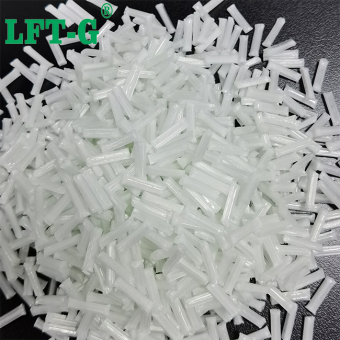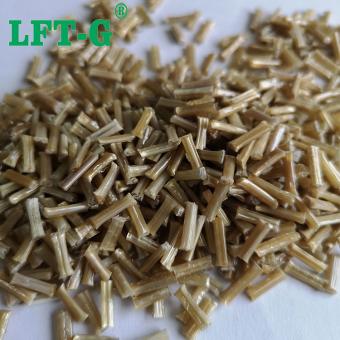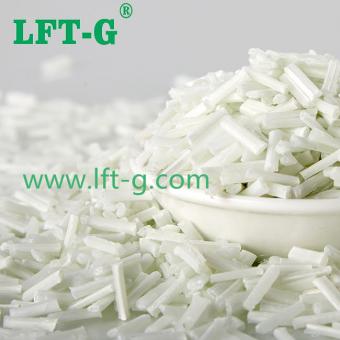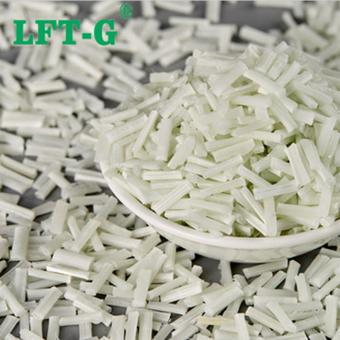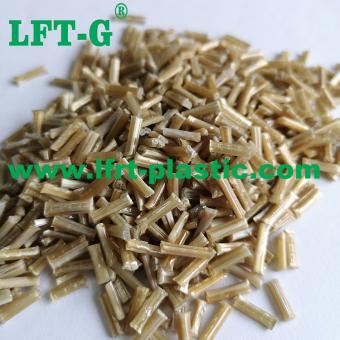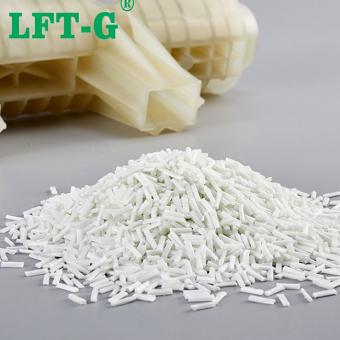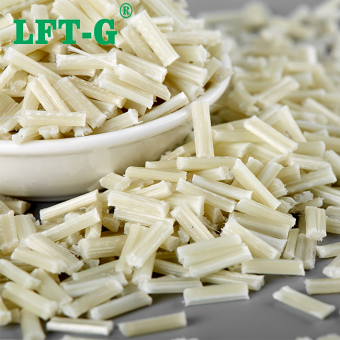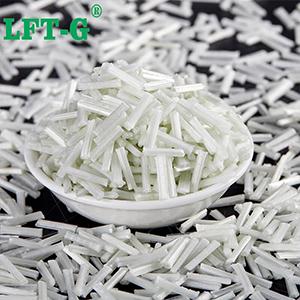-
Raw material composite Polypropylene Long Glass Fiber40Product introduction Long glass fiber reinforced polypropylene (PP-LGF) material has been widely used in the automobile industry because of its advantages of light weight, high specific strength, good heat resistance and recycling, etc. Long glass fiber reinforced polypropylene (PP-LGF) material has low cost, high specific strength and high heat resistance and so on. Since it was developed in the early 1980s, The hope is to replace some metal or engineering plastics in car parts. Polypropylene Long Glass Fiber40
- glass fiber filling
- cost effectively reduce
- instead medal
- excellent resistance to creep and fatigue
- low warpage
- customized color
Tags :
-
LFT-G PPS Polyphenylene sulfide composite long glass fiber thermoplastic resin original colorPPS information The resin matrix of thermoplastic composites involves general and special engineering plastics, and PPS is a typical representative of special engineering plastics, commonly known as "plastic gold". Performance advantages include the following aspects: excellent heat resistance, good mechanical properties, corrosion resistance, self-flame retardant up to UL94 V-0 level. Because PPS has the advantages of the above properties, and compared with other high performance thermoplastic engineering plastics and has the characteristics of easy processing, low cost, so it becomes an excellent resin matrix for manufacturing composite materials. PPS composite material PPS filling short glass fiber (SGF) composite material has the advantages of high strength, high heat resistance, flame retardant, easy processing, low cost, and has been applied in automotive, electronics, electrical, machinery, instruments, aviation, aerospace, military and other fields. PPS filling long glass fiber (LGF) composite material has the advantages of high toughness, low warpage, fatigue resistance, good product appearance and so on. It can be used in water heater impeller, pump shell, joint, valve, chemical pump impeller and shell, cooling water impeller and shell, household appliance parts and so on. What are the specific differences between short glass fiber (SGF) and long glass fiber (LGF) reinforced PPS composites? 1. Mechanical property analysis The reinforcement fiber added in the resin matrix can form a supporting skeleton, and the reinforcement fiber can effectively bear the external load when the composite is subjected to external force. At the same time, energy can be absorbed by fracture, deformation and other ways to improve the mechanical properties of resin. The tensile strength and bending strength of the composites are gradually increased by increasing the amount of glass fiber. The main reason is that when the glass fiber content increases, more glass fiber in the composite material can withstand the action of external force. Meanwhile, due to the increase in the number of glass fibers, the resin matrix between the glass fibers becomes thinner, which is more conducive to the construction of glass fiber reinforced frame. Therefore, with the increase of glass fiber content, more stress is transferred from resin to glass fiber under external load, which effectively improves the tensile and bending properties of composite materials. The tensile and bending properties of PPS/LGF composites are higher than those of PPS/SGF composites. When the glass fiber mass fraction is 30%, the tensile strength of PPS/SGF and PPS/LGF composites is 110MPa and 122MPa, respectively. The bending strength was 175MPa and 208MPa, respectively. The flexural elastic modulus were 8GPa and 9GPa, respectively. The tensile strength, bending strength and bending elastic modulus of PPS/LGF composites are increased by 11.0%, 18.9% and 11.3% compared with PPS/SGF composites, respectively. PPS/LGF composites have higher length retention rate of glass fiber. Under the condition of the same glass fiber content, the composites have stronger load resistance and better mechanical properties. When the glass fiber content is low, the impact strength of the composite decreases. The main reason is that the lower glass fiber content cannot form a good stress transfer network in the composite material, so that the glass fiber exists in the form of defects under the impact load of the composite material, resulting in the overall impact strength of the composite material is reduced. With the increase of the glass fiber content, the glass fiber in the composite can form an effective spatial network, and the reinforcement effect is greater than that of the glass fiber tip. Under the action of external load, the external load can be transferred to the reinforced fiber better, thus improving the overall performance of the composite. In the PPS/LGF system, the length of the glass fiber is longer and the spatial network is more dense. The reinforced glass fiber has greater bearing capacity and better impact strength. When the mass fraction of glass fiber is 30%, the impact strength of PPS/LGF is increased by 19.4% from 31kJ/m2 to 37kJ/m2, and the notch impact strength is increased by 54.5%(from 7.7kJ/m2 to 11.9kJ/m2). 2. Thermal properties analysis of PPS/SGF and PPS/LGF composites When the mass fraction of glass fiber is 30%, the thermal deformation temperature of PPS/SGF composite and PPS/LGF composite reaches 250℃ and 275℃, respectively. The thermal deformation temperature of PPS/LGF composite is 10% higher than that of PPS/SGF composite. The main reason is that the introduction of glass fiber makes the network skeleton of reinforced fiber formed inside the composite material, which greatly improves the heat resistance of the composite material. The size of glass fiber in PPS/LGF is longer, and the heat resistance improvement advantage is more obvious....
- New high performance thermoplastic resin
- A crystalline polymer
- Long glass fiber filling plastic
- Customized material
- Industrial raw material
- High impact resistance
Tags :
-
Transparent and light PP Long Glass Fiber composite material thermoplastic resin sample freePolypropylene (PP), as one of the five general plastics, is widely used in all walks of life
- white plastic material
- long glass fiber
- PP composite
- plastic grains
- Polypropylene fibre
- glass fiber filling plastic
Tags :
-
HDPE LFT-G filling Long Glass Fiber 20%-60% natural grade high performance sample availableHDPE introduce High density polyethylene (HDPE) is a white powder or granular product. Non-toxic, tasteless, crystallinity is 80% ~ 90%, softening point is 125 ~ 135℃, the use of temperature can reach 100℃; The hardness, tensile strength and creep property are better than low density polyethylene. Good wear resistance, electrical insulation, toughness and cold resistance; Good chemical stability, at room temperature, insoluble in any organic solvent, acid, alkali and all kinds of salt corrosion resistance; Thin film to water vapor and air permeability is small, low water absorption; Poor aging resistance, environmental stress cracking resistance is not as good as low density polyethylene, especially thermal oxidation will reduce its performance, so the resin must be added in antioxidants and ultraviolet absorbent to improve this deficiency. High density polyethylene film under the condition of stress thermal deformation temperature is low, should pay attention to the application. Long Glass Fiber filling High density polyethylene (HDPE)/ glass fiber (LGF) composites were prepared by twin-screw extrusion mechanism, and the mechanical properties and non-isothermal crystallization behavior of HDPE/LGF composites were studied. The results show that the impact strength of the composite can be improved by MAH-g-POE, and the interface bond between the glass fiber and HDPE is good. The Avrami index (n) of the composite does not change with the cooling rate. The effects of HDPE on the flow properties of PP and its mechanical properties, and the effects of the flow properties of PP/HDPE blends on the mechanical properties of LGF/PP/HDPE composites were studied. The results show that HDPE can not only improve the impact performance of PP, but also improve the liquidity of PP. The mechanical properties of LGF/PP/HDPE composites, such as tensile strength and bending strength, are mainly affected by the flow properties of the matrix, but have little effect on the mechanical properties of the matrix itself. Datasheet Tested by own lab, for your reference only. Application cases Package and Warehouse Self-owned factory Exhibitions and customers Frequently asked questions 1. Under what circumstances can long fiber replace short fiber? What are the common alternative materials? A: Traditional staple fiber materials can be replaced with long glass fiber and long carbon fiber LFT materials in the case of customers whose mechanical properties cannot be met or where higher metal substitutes are desired. For example, PP long glass fiber is often replacing nylon reinforced glass fiber, and nylon long glass fiber is replacing PPS series. 2. How to choose the fiber content of the product? Is the larger product suitable for higher content material? A: This is not absolute. The content of glass fiber is not more is better. The suitable content is just to meet the requirements of each products. 3. If want to increase the anti-aging properties of the product, is it possible to add anti-UV agent to the material? A: You can choose some materials which are better resistant to aging, and then add some antioxidants and UV absorbers to the materials, to improve the aging resistance of the products.
- HDPE filling lgf
- High Density Polyethylene raw material
- Granular plastic HDPE
- Reinforced materials HDPE
- long fiber material
Tags :
-
LFT-G PPS Polyphenylene sulfide LGF composite long glass fiber customized color engineering plasticsWhat is the PPS? Polyphenylene sulfide (PPS) is a new thermoplastic resin with high performance. By filling, modified with excellent high temperature resistance, corrosion resistance, wear resistance, flame retardant, balanced physical and mechanical properties and excellent dimensional stability and excellent electrical properties and other characteristics of the new high performance thermoplastic resin, as well as high mechanical strength, chemical resistance, flame resistance, good thermal stability, excellent electrical properties and other advantages. It has the advantages of hard and brittle, high crystallinity, inflammability, good thermal stability, high mechanical strength, excellent electrical properties, strong chemical corrosion resistance and so on. The mechanical properties of pure PPS are not high, especially the impact strength is relatively low. Good creep resistance under load, high hardness; High wear resistance, the wear at 1000 RPM is only 0.04g, and will be further improved after filling F4 and molybdenum disulfide; It also has a certain degree of self-moistening. The mechanical properties of PPS are less sensitive to temperature. What is the PPS-LGF? PPS is one of the best varieties of heat resistance in the engineering plastic department. The thermal deformation temperature of the material modified by glass fiber is generally greater than 260 degrees, and the chemical resistance is second only to PTFE. In addition, it also has small shrinkage, low water absorption, good fire resistance. Good resistance to vibration fatigue, strong resistance to arc, especially at high temperature. Excellent electrical insulation in high humidity. But its disadvantages are brittleness, toughness, low impact strength, after modification, can overcome the above shortcomings, obtain very excellent comprehensive performance. As a plastic, its properties and uses far exceed those of ordinary plastics, and in many ways it is as good as metal materials. Excellent material PPS has the advantages of high temperature corrosion resistance, excellent mechanical properties, can replace metal including stainless steel, copper, aluminum, alloy, etc., is considered to be the best substitute for metal, copper. What is the application of PPS-LGF? PPS is now widely used in automotive, aerospace, household appliances, mechanical construction and chemical industry for a variety of structural parts, transmission parts, insulation parts, corrosion resistant parts and seals. Under the condition of ensuring sufficient strength and other properties, the weight of the product is greatly reduced. Datasheet for reference Details Number Color Length MOQ Package Sample Delivery time Port of Loading PPS-NA-LGF30 Original color (can be customized) 5-25mm above 25kg 25kg/bag Available 7-15 days after shipment Xiamen Poer Production process Trademarks and patents Teams and customers We will offer you: 1. LFT & LFRT material technical parameters and leading edge design 2. Mold front design and recommendations 3. Provide technical support such as injection molding and extrusion molding.
- PPS Long glass fiber 40
- pps compounds lgf
- pps resin materials lft
- lft-g pps reinforced plastic
- long glass fiber filling pps
- termoplastic resin pps lgf
Tags :
-
LFT-G PLA Polylactic acid composite long glass fiber thermoplastic resin original colorPLA PLA (polylactic acid) is also known as polylactic acid, the production process of polylactic acid is pollution-free, and the product can be biodegradable to achieve recycling in nature, so it is an ideal green polymer material, and one of the representatives of biodegradable plastics. The structure of PLA has important influence on its heat resistance, toughness, mechanical strength, degradability and biocompatibility. The influence on heat resistance is mainly discussed below. There is only one submethylene on the main chain of PLA molecule, the molecular chain has a spiral structure, and its activity is poor. As a result, the PLA after injection molding almost does not crystallize due to slow crystallization speed, so the heat resistance of the product is poor. During hot processing, the ester bond is partially broken to produce terminal carboxyl group, which plays an autocatalytic degradation effect on the thermal degradation of PLA. LGF reinforced PLA The rigidity of the fiber makes it play the role of skeleton support in the polymer matrix. When the polymer is heated, the movement of the chain segment is limited, thus improving the heat resistance of the material. At present, the fibers that can be used for enhancement modification of PLA include natural plant fiber (sisal, flax, linen, bamboo, coconut, wood fiber, etc.), natural animal fiber (silk, etc.), mineral fiber (basalt fiber, etc.), and chemical fiber (carbon fiber, glass fiber, etc.). Among these fibers, carbon fiber and glass fiber are widely used for their high strength and high modulus. Natural plant fiber has been widely studied because of its wide source, degradability and improved thermal and mechanical properties of composites. Modified natural fiber and modified inorganic fiber (glass fiber or carbon fiber) were mixed into the PLA matrix to prepare two kinds of fiber reinforced PLA composites. The test results show that the Vica softening temperature of the composites exceeds 140℃. Compared with Short fiber(SGF) Compared with the short fiber, it has more excellent performance in mechanical properties. It is more suitable for large products and structural parts. It has 1-3 times higher (toughness) than short fiber, and the tensile strength (strength and rigidity) is increased by 0.5-1 times. Injection molding Lab Warehouse Certification Xiamen LFT composite plastic Co., Ltd Xiamen LFT composite plastic Co., Ltd. is a brand-name company that focuses on LFT&LFRT. Long Glass Fiber Series (LGF) & Long Carbon Fiber Series (LCF). The company's thermoplastic LFT can be used for LFT-G injection molding and extrusion, and can also be used for LFT-D molding. It can be produced according to customer requirements: 5~25mm in length. The company's long-fiber continuous infiltration reinforced thermoplastics have passed ISO9001&16949 system certification, and the products have obtained lots of national trademarks and patents.
- PLA composite plastic
- polyactic acid materials
- modified pla compounds
- pla long glass fiber lgf
- long glass fiber filling pla
- lft-g pla lgf
Tags :
-
LFT-G PPA Long Glass fiber higher toughness reinforced plastic polymer for machanical parts 12mm original colorPPA-LGF(Long Glass Fiber) Grade: general grade Fiber specification: 20%-60% Color: Original color (can be customized) Length: 12mm or so (can be customized) Feature: high toughness, low warpage
- Polyphthalamide resins ppa
- lgf ppa lft-g
- reinforced ppa instead metal steel
- Modified PPA GFRP
- long glass fiber filling ppa plastic
- thermoplastic resin ppa gf30 high strength
Tags :
-
LFT-G Polypropylene PP modofied material filling long glass fiber compounds higher performance virgin gradePP-LGF Among many composite materials, long glass reinforced polypropylene material (PP-LGF) has gained more popularity for its low price, excellent mechanical properties and environmental friendliness.Compared with short glass fiber reinforced polypropylene material (PP-SGF), PP-LGF has more advantages in strength, stiffness, warpage, fatigue resistance, notch impact strength and dimensional stability, so products produced with PP-LGF can further achieve weight and cost reduction. The length of PP-LGF particles produced by our company is generally 8mm~15mm, in which the content of glass fiber can reach 20%~60%, and the retained length of glass fiber in the particles can reach 1mm~3mm, compared with PP-SGF materials whose retained length of glass fiber is only 0.2mm~0.4mm, PP-LGF can guarantee the following characteristics due to the three-dimensional network structure of its internal fiber. 1. Low density: The use of long glass fiber reinforced composite material instead of steel is an effective way to reduce the weight of the product. 2. High strength: The composite material with modified resin and different length of fiber has high mechanical strength, good rigidity and impact performance, which can replace steel plate to make coverings or structural parts. 3. Low cost: The use of long glass fiber reinforced composite materials instead of metal materials can simplify the design of complex metal parts and achieve the purpose of forming complex parts at one time. 4. Impact resistance: The elastic deformation property of resin makes long glass fiber reinforced composite materials have certain function of absorbing collision energy, and have a large buffering effect on the impact of certain speed. 5. Corrosion resistance: The composite material has strong corrosion resistance, and its corrosion resistance to acid, alkali and salt is better than that of metal. 6. Beauty: most resins have good colorability, and can be made into various colors by adding masterbatch or spraying paint on the surface; through injection and molding, various irregular curvature shapes can be realized. Datasheet for reference Tests Application As the hottest material, our customers have applied the PP-LGF in many fields, like car parts, washing machine parts, etc. Just contact us, and we will provide technical support. About company Xiamen LFT composite plastic Co., Ltd. is a brand-name company that focuses on LFT&LFRT. Long Glass Fiber Series (LGF) & Long Carbon Fiber Series (LCF). The company's thermoplastic LFT can be used for LFT-G injection molding and extrusion, and can also be used for LFT-D molding. It can be produced according to customer requirements: 5~25mm length. The company's long-fiber continuous infiltration reinforced thermoplastics have passed ISO9001&16949 system certification, and the products have obtained lots of national trademarks and patents.
- PP resin lgf gfrp
- good price PP reinforced gf
- instead metal pp plastic long fiebr glass
- thermoplastic PP long fiber
- pp-na-lgf 30 lft white
- glass fiber filling Polypropylene 30%
Tags :
-
LFT-G Polypropylene PP modofied material filling long glass fiber compounds higher performance virgin gradePP-LGF Among many composite materials, long glass reinforced polypropylene material (PP-LGF) has gained more popularity for its low price, excellent mechanical properties and environmental friendliness.Compared with short glass fiber reinforced polypropylene material (PP-SGF), PP-LGF has more advantages in strength, stiffness, warpage, fatigue resistance, notch impact strength and dimensional stability, so products produced with PP-LGF can further achieve weight and cost reduction. The length of PP-LGF particles produced by our company is generally 8mm~15mm, in which the content of glass fiber can reach 20%~60%, and the retained length of glass fiber in the particles can reach 1mm~3mm, compared with PP-SGF materials whose retained length of glass fiber is only 0.2mm~0.4mm, PP-LGF can guarantee the following characteristics due to the three-dimensional network structure of its internal fiber. 1. Low density: The use of long glass fiber reinforced composite material instead of steel is an effective way to reduce the weight of the product. 2. High strength: The composite material with modified resin and different length of fiber has high mechanical strength, good rigidity and impact performance, which can replace steel plate to make coverings or structural parts. 3. Low cost: The use of long glass fiber reinforced composite materials instead of metal materials can simplify the design of complex metal parts and achieve the purpose of forming complex parts at one time. 4. Impact resistance: The elastic deformation property of resin makes long glass fiber reinforced composite materials have certain function of absorbing collision energy, and have a large buffering effect on the impact of certain speed. 5. Corrosion resistance: The composite material has strong corrosion resistance, and its corrosion resistance to acid, alkali and salt is better than that of metal. 6. Beauty: most resins have good colorability, and can be made into various colors by adding masterbatch or spraying paint on the surface; through injection and molding, various irregular curvature shapes can be realized. Datasheet for reference Tests Application As the hottest material, our customers have applied the PP-LGF in many fields, like car parts, washing machine parts, etc. Just contact us, and we will provide technical support. About company Xiamen LFT composite plastic Co., Ltd. is a brand-name company that focuses on LFT&LFRT. Long Glass Fiber Series (LGF) & Long Carbon Fiber Series (LCF). The company's thermoplastic LFT can be used for LFT-G injection molding and extrusion, and can also be used for LFT-D molding. It can be produced according to customer requirements: 5~25mm length. The company's long-fiber continuous infiltration reinforced thermoplastics have passed ISO9001&16949 system certification, and the products have obtained lots of national trademarks and patents.view more
-
LFT-G Polypropylene PP modofied material filling long glass fiber compounds higher performance virgin gradePP-LGF Among many composite materials, long glass reinforced polypropylene material (PP-LGF) has gained more popularity for its low price, excellent mechanical properties and environmental friendliness.Compared with short glass fiber reinforced polypropylene material (PP-SGF), PP-LGF has more advantages in strength, stiffness, warpage, fatigue resistance, notch impact strength and dimensional stability, so products produced with PP-LGF can further achieve weight and cost reduction. The length of PP-LGF particles produced by our company is generally 8mm~15mm, in which the content of glass fiber can reach 20%~60%, and the retained length of glass fiber in the particles can reach 1mm~3mm, compared with PP-SGF materials whose retained length of glass fiber is only 0.2mm~0.4mm, PP-LGF can guarantee the following characteristics due to the three-dimensional network structure of its internal fiber. 1. Low density: The use of long glass fiber reinforced composite material instead of steel is an effective way to reduce the weight of the product. 2. High strength: The composite material with modified resin and different length of fiber has high mechanical strength, good rigidity and impact performance, which can replace steel plate to make coverings or structural parts. 3. Low cost: The use of long glass fiber reinforced composite materials instead of metal materials can simplify the design of complex metal parts and achieve the purpose of forming complex parts at one time. 4. Impact resistance: The elastic deformation property of resin makes long glass fiber reinforced composite materials have certain function of absorbing collision energy, and have a large buffering effect on the impact of certain speed. 5. Corrosion resistance: The composite material has strong corrosion resistance, and its corrosion resistance to acid, alkali and salt is better than that of metal. 6. Beauty: most resins have good colorability, and can be made into various colors by adding masterbatch or spraying paint on the surface; through injection and molding, various irregular curvature shapes can be realized. Datasheet for reference Tests Application As the hottest material, our customers have applied the PP-LGF in many fields, like car parts, washing machine parts, etc. Just contact us, and we will provide technical support. About company Xiamen LFT composite plastic Co., Ltd. is a brand-name company that focuses on LFT&LFRT. Long Glass Fiber Series (LGF) & Long Carbon Fiber Series (LCF). The company's thermoplastic LFT can be used for LFT-G injection molding and extrusion, and can also be used for LFT-D molding. It can be produced according to customer requirements: 5~25mm length. The company's long-fiber continuous infiltration reinforced thermoplastics have passed ISO9001&16949 system certification, and the products have obtained lots of national trademarks and patents.view more
-
Xiamen LFT-G PLA Polylactic acid composite long glass fiber filling thermoplastic resin original colorPLA PLA (polylactic acid) is also known as polylactic acid, the production process of polylactic acid is pollution-free, and the product can be biodegradable to achieve recycling in nature, so it is an ideal green polymer material, and one of the representatives of biodegradable plastics. The structure of PLA has important influence on its heat resistance, toughness, mechanical strength, degradability and biocompatibility. The influence on heat resistance is mainly discussed below. There is only one submethylene on the main chain of PLA molecule, the molecular chain has a spiral structure, and its activity is poor. As a result, the PLA after injection molding almost does not crystallize due to slow crystallization speed, so the heat resistance of the product is poor. During hot processing, the ester bond is partially broken to produce terminal carboxyl group, which plays an autocatalytic degradation effect on the thermal degradation of PLA. LGF reinforced PLA The rigidity of the fiber makes it play the role of skeleton support in the polymer matrix. When the polymer is heated, the movement of the chain segment is limited, thus improving the heat resistance of the material. At present, the fibers that can be used for enhancement modification of PLA include natural plant fiber (sisal, flax, linen, bamboo, coconut, wood fiber, etc.), natural animal fiber (silk, etc.), mineral fiber (basalt fiber, etc.), and chemical fiber (carbon fiber, glass fiber, etc.). Among these fibers, carbon fiber and glass fiber are widely used for their high strength and high modulus. Natural plant fiber has been widely studied because of its wide source, degradability and improved thermal and mechanical properties of composites. Modified natural fiber and modified inorganic fiber (glass fiber or carbon fiber) were mixed into the PLA matrix to prepare two kinds of fiber reinforced PLA composites. The test results show that the Vica softening temperature of the composites exceeds 140℃. Compared with Short fiber(SGF) Compared with the short fiber, it has more excellent performance in mechanical properties. It is more suitable for large products and structural parts. It has 1-3 times higher (toughness) than short fiber, and the tensile strength (strength and rigidity) is increased by 0.5-1 times. Injection molding Lab Warehouse Certification Xiamen LFT composite plastic Co., Ltd Xiamen LFT composite plastic Co., Ltd. is a brand-name company that focuses on LFT&LFRT. Long Glass Fiber Series (LGF) & Long Carbon Fiber Series (LCF). The company's thermoplastic LFT can be used for LFT-G injection molding and extrusion, and can also be used for LFT-D molding. It can be produced according to customer requirements: 5~25mm in length. The company's long-fiber continuous infiltration reinforced thermoplastics have passed ISO9001&16949 system certification, and the products have obtained lots of national trademarks and patents.
- PLA composite plastic can be recycled
- polyactic acid materials injection molding
- pla long glass fiber reinforced plastic resin
- long glass fiber filling pla sample available
- lft-g pla lgf low warpage
Tags :
-
LFT-G PLA Polylactic acid composite long glass fiber thermoplastic original colorPLA PLA (polylactic acid) is also known as polylactic acid, the production process of polylactic acid is pollution-free, and the product can be biodegradable to achieve recycling in nature, so it is an ideal green polymer material, and one of the representatives of biodegradable plastics. The structure of PLA has important influence on its heat resistance, toughness, mechanical strength, degradability and biocompatibility. The influence on heat resistance is mainly discussed below. There is only one submethylene on the main chain of PLA molecule, the molecular chain has a spiral structure, and its activity is poor. As a result, the PLA after injection molding almost does not crystallize due to slow crystallization speed, so the heat resistance of the product is poor. During hot processing, the ester bond is partially broken to produce terminal carboxyl group, which plays an autocatalytic degradation effect on the thermal degradation of PLA. LGF reinforced PLA The rigidity of the fiber makes it play the role of skeleton support in the polymer matrix. When the polymer is heated, the movement of the chain segment is limited, thus improving the heat resistance of the material. At present, the fibers that can be used for enhancement modification of PLA include natural plant fiber (sisal, flax, linen, bamboo, coconut, wood fiber, etc.), natural animal fiber (silk, etc.), mineral fiber (basalt fiber, etc.), and chemical fiber (carbon fiber, glass fiber, etc.). Among these fibers, carbon fiber and glass fiber are widely used for their high strength and high modulus. Natural plant fiber has been widely studied because of its wide source, degradability and improved thermal and mechanical properties of composites. Modified natural fiber and modified inorganic fiber (glass fiber or carbon fiber) were mixed into the PLA matrix to prepare two kinds of fiber reinforced PLA composites. The test results show that the Vica softening temperature of the composites exceeds 140℃. Compared with Short fiber(SGF) Compared with the short fiber, it has more excellent performance in mechanical properties. It is more suitable for large products and structural parts. It has 1-3 times higher (toughness) than short fiber, and the tensile strength (strength and rigidity) is increased by 0.5-1 times. Injection molding Lab Warehouse Certification Xiamen LFT composite plastic Co., Ltd Xiamen LFT composite plastic Co., Ltd. is a brand-name company that focuses on LFT&LFRT. Long Glass Fiber Series (LGF) & Long Carbon Fiber Series (LCF). The company's thermoplastic LFT can be used for LFT-G injection molding and extrusion, and can also be used for LFT-D molding. It can be produced according to customer requirements: 5~25mm in length. The company's long-fiber continuous infiltration reinforced thermoplastics have passed ISO9001&16949 system certification, and the products have obtained lots of national trademarks and patents.view more

 e-mail
e-mail English
English français
français Deutsch
Deutsch русский
русский italiano
italiano español
español português
português العربية
العربية 日本語
日本語 한국의
한국의 中文
中文












